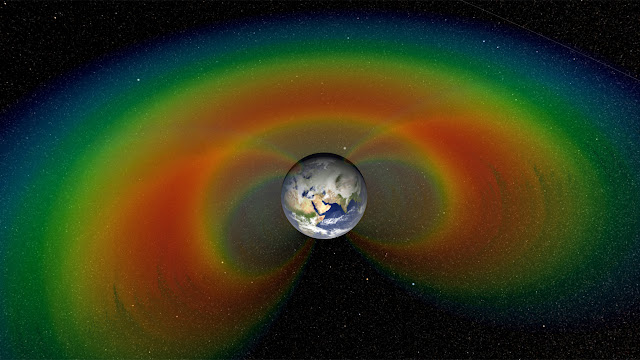NASA - InSight Mission patch.
October 18, 2019
NASA's InSight spacecraft has used its robotic arm to help its heat probe, known as "the mole," dig nearly 2 centimeters (3/4 of an inch) over the past week. While modest, the movement is significant: Designed to dig as much as 16 feet (5 meters) underground to gauge the heat escaping from the planet's interior, the mole has only managed to partially bury itself since it started hammering in February 2019.
Animation above: This GIF shows NASA InSight's heat probe, or "mole," digging about a centimeter (half an inch) below the surface last week. Using a technique called "pinning," InSight recently pressed the scoop on its robotic arm against the self-hammering mole in order to help it dig. Animation Credit: NASA/JPL-Caltech.
The recent movement is the result of a new strategy, arrived at after extensive testing on Earth, which found that unexpectedly strong soil is holding up the mole's progress. The mole needs friction from surrounding soil in order to move: Without it, recoil from its self-hammering action will cause it to simply bounce in place. Pressing the scoop on InSight's robotic arm against the mole, a new technique called "pinning," appears to provide the probe with the friction it needs to continue digging.
Since Oct. 8, 2019, the mole has hammered 220 times over three separate occasions. Images sent down from the spacecraft's cameras have shown the mole gradually progressing into the ground. It will take more time - and hammering - for the team to see how far the mole can go.
The mole is part of an instrument called the Heat Flow and Physical Properties Package, or HP3, which was provided by the German Aerospace Center (DLR).
"Seeing the mole's progress seems to indicate that there's no rock blocking our path," said HP3 Principal Investigator Tilman Spohn of DLR. "That's great news! We're rooting for our mole to keep going."
NASA's Jet Propulsion Laboratory in Pasadena, California, leads the InSight mission. JPL has tested the robotic arm's movement using full-scale replicas of InSight and the mole. Engineers continue to test what would happen if the mole were to sink beneath the reach of the robotic arm. If it stops making progress, they might scrape soil on top of the mole, adding mass to resist the mole's recoil.
InSight on Mars. Image Credits: NASA/JPL
If no other options exist, they would consider pressing the scoop down directly on the top of the mole while trying to avoid the sensitive tether there; the tether provides power to and relays data from the instrument.
"The mole still has a way to go, but we're all thrilled to see it digging again," said Troy Hudson of JPL, an engineer and scientist who has led the mole recovery effort. "When we first encountered this problem, it was crushing. But I thought, 'Maybe there's a chance; let's keep pressing on.' And right now, I'm feeling giddy."
About InSight
JPL manages InSight for NASA's Science Mission Directorate. InSight is part of NASA's Discovery Program, managed by the agency's Marshall Space Flight Center in Huntsville, Alabama. Lockheed Martin Space in Denver built the InSight spacecraft, including its cruise stage and lander, and supports spacecraft operations for the mission.
A number of European partners, including France's Centre National d'Études Spatiales (CNES) and the German Aerospace Center (DLR), are supporting the InSight mission. CNES provided the Seismic Experiment for Interior Structure (SEIS) instrument to NASA, with the principal investigator at IPGP (Institut de Physique du Globe de Paris). Significant contributions for SEIS came from IPGP; the Max Planck Institute for Solar System Research (MPS) in Germany; the Swiss Federal Institute of Technology (ETH Zurich) in Switzerland; Imperial College London and Oxford University in the United Kingdom; and JPL. DLR provided the Heat Flow and Physical Properties Package (HP3) instrument, with significant contributions from the Space Research Center (CBK) of the Polish Academy of Sciences and Astronika in Poland. Spain's Centro de Astrobiología (CAB) supplied the temperature and wind sensors.
Related article:
NASA's Push to Save the Mars InSight Lander's Heat Probe
https://orbiterchspacenews.blogspot.com/2019/10/nasas-push-to-save-mars-insight-landers.html
More about InSight:
https://mars.nasa.gov/insight/
https://www.nasa.gov/insight/
Seismic Experiment for Interior Structure (SEIS): https://mars.nasa.gov/insight/mission/instruments/seis/
Animation (mentioned), Image (mentioned), Text, Credits: NASA/Alana Johnson/JPL/Andrew Good.
Greetings, Orbiter.ch









































